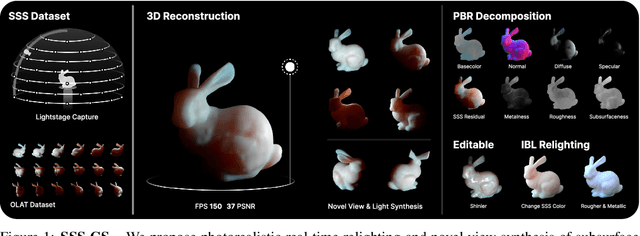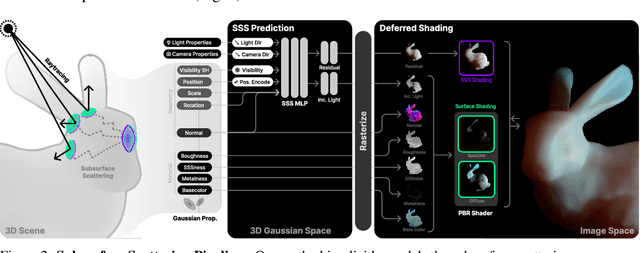Jan-Niklas Dihlmann
Subsurface Scattering for 3D Gaussian Splatting
Aug 22, 2024



Abstract:3D reconstruction and relighting of objects made from scattering materials present a significant challenge due to the complex light transport beneath the surface. 3D Gaussian Splatting introduced high-quality novel view synthesis at real-time speeds. While 3D Gaussians efficiently approximate an object's surface, they fail to capture the volumetric properties of subsurface scattering. We propose a framework for optimizing an object's shape together with the radiance transfer field given multi-view OLAT (one light at a time) data. Our method decomposes the scene into an explicit surface represented as 3D Gaussians, with a spatially varying BRDF, and an implicit volumetric representation of the scattering component. A learned incident light field accounts for shadowing. We optimize all parameters jointly via ray-traced differentiable rendering. Our approach enables material editing, relighting and novel view synthesis at interactive rates. We show successful application on synthetic data and introduce a newly acquired multi-view multi-light dataset of objects in a light-stage setup. Compared to previous work we achieve comparable or better results at a fraction of optimization and rendering time while enabling detailed control over material attributes. Project page https://sss.jdihlmann.com/
SIGNeRF: Scene Integrated Generation for Neural Radiance Fields
Jan 03, 2024Abstract:Advances in image diffusion models have recently led to notable improvements in the generation of high-quality images. In combination with Neural Radiance Fields (NeRFs), they enabled new opportunities in 3D generation. However, most generative 3D approaches are object-centric and applying them to editing existing photorealistic scenes is not trivial. We propose SIGNeRF, a novel approach for fast and controllable NeRF scene editing and scene-integrated object generation. A new generative update strategy ensures 3D consistency across the edited images, without requiring iterative optimization. We find that depth-conditioned diffusion models inherently possess the capability to generate 3D consistent views by requesting a grid of images instead of single views. Based on these insights, we introduce a multi-view reference sheet of modified images. Our method updates an image collection consistently based on the reference sheet and refines the original NeRF with the newly generated image set in one go. By exploiting the depth conditioning mechanism of the image diffusion model, we gain fine control over the spatial location of the edit and enforce shape guidance by a selected region or an external mesh.
 Add to Chrome
Add to Chrome Add to Firefox
Add to Firefox Add to Edge
Add to Edge